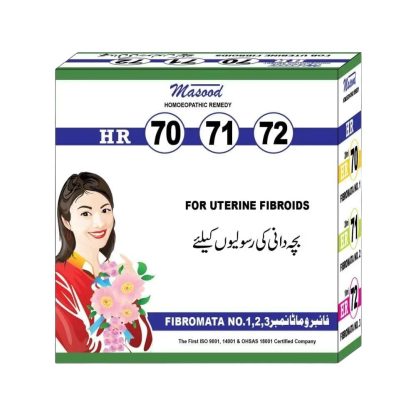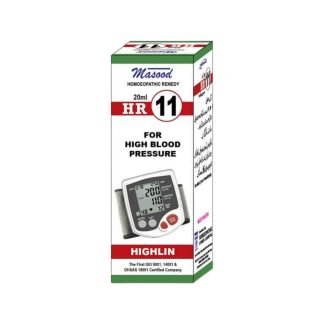Description
HR 70 – 71 – 72 Masood is effective for uterine fibroids.
Indicated in heavy uterine bleeding due to fibroids.
Reduces the pressure and heaviness symptoms in lower abdomen.
Helpful for anemia, lethargy and dysmenorrhea.
Diminish the discomfort during urination or parturition.
Also prevent the recurrence of uterine fibroids.
Presentation: Bottle of 20 ml.
Dosage: For HR 70, 71: 30 drops 3 times a day with fresh water. For HR 72: 5 drops 3 times a day with fresh water.
Note: Consult your Homoeopathic Doctor before taking this medication.
Side Effects: No side effects are known.
Contraindications: Consult your Homeopathic Doctor during pregnancy and lactation.
Interaction: No interaction with other products are Known.
Introduction:
Uterine Fibroids:
Fibroids are muscular tumors that grow in the wall of the uterus (womb). Another medical term for fibroids is leiomyoma or just “myoma”.
Fibroids are almost always benign (not cancerous). Fibroids can grow as a single tumor, or there can be many of them in the uterus.
They can be as small as an apple seed or as big as a grapefruit. In unusual cases they can become very large.
Types:
The type of fibroid develops depends on its location in or on the uterus.
Subserosal fibroids:
Subserosal fibroids form on the outside of uterus, which is called the serosa. They may grow large enough to make womb appear bigger on one side.
Pedunculated fibroids:
Subserosal tumors can develop a stem, a slender base that supports the tumor. When they do, they’re known as pedunculated fibroids.
Submucosal fibroids:
These types of tumors develop in the middle muscle layer, or myometrium, of uterus. Submucosal tumors aren’t as common as the other types.
Causes:
Although exact causes are unknown, research evidence suggests that any or all of these factors might play a role in the growth of uterine fibroids.
Genetics
Estrogen and progesterone
Growth hormones
Micronutrients, such as iron, that the body needs only small amounts of in the blood. For instance, a deficiency of vitamin D may be associated with uterine fibroids.
Major stresses.
Symptoms:
Symptoms might include:
Heavy bleeding or painful periods
Bleeding between periods
Pressure, pain, or fullness in lower stomach
Enlarged abdomen or uterus
Constipation
Needing to pee often or trouble emptying bladder
Pain during sex
Miscarriages or infertility
Indications:
Uterine fibroids are benign tumors forming in uterus. Most women suffering from uterine fibroids show now symptom. However fibroids can cause a number of symptoms depending on their size location within the uterus. Most common signs and symptoms of uterine fibroids are pressure, pelvic pain, pressure on the bladder with frequent or even obstructed urination. Pressure on the rectum with painful or difficult defecation occasionally recurrent miscarriage
Pharmacology:
Fibromata contains xanthoxylin, which is a main constituent , acts best in uterine fibroids by its excellent pain controller, hormone balancing character and having enough quantity of iron and vitamin B12. It increases bodily resistance to infection as antiseptic and is used for boils, erysipelas, septicemia, cancer, syphilis and other impurities of the blood. It has also useful properties as a strong alterative and aphrodisiac. It has an astringent and anti-inflammatory, Aromatic, astringent and diuretic. It is used in intermittent fevers, rheumatism and dropsy.
Its specific indication is Feeble tissues, with tardy removal of broken-down material, and slow renewal of the parts; mucous membranes, tumid, red, and glistening, with scanty secretion an important remedy syphilitic affections. It is used as uterine tonic. It exerts a specific influence upon the reproductive organs of the female. It may be prescribed in all cases in which there is an atonic condition of ovaries or uterus, amenorrhea, dysmenorrhoea or menorrhagia and increased mucous or purulent secretion.
It is best indicated in uterine diseases, in uterine tumors, of speedy growth, and in hypertrophy of the uterus, it influences cell proliferation in hypertrophy, assisting in the reduction of size of an enlarged organ and in the restoration of a correct position, normal function and normal size.
Formula:
HR 70:
Each 1ml contains:
Echinacea Ang 1D 20% v/v
Ceanothus Am 1D 20% v/v
Baptisia Tinct 1D 20% v/v
Iris Vers 1D 10% v/v
Stillingia Syl 1D 10% v/v
Thuja Occi 1D 10% v/v
Xanthoxylum Fraxi 1D 10% v/v
With excipients q.s.
HR 71:
Each 1ml contains:
Ceanothus Am 1D 15% v/v
Senecio Aur 1D 15% v/v
Fraxinus Am 1D 10% v/v
Helonias Dio 1D 15% v/v
Hydrastis Can 1D 15% v/v
Lobelia Inf 1D 10% v/v
Podophyllum Pel 1D 10% v/v
Zingiber off 1D 10% v/v
With excipients q.s.
HR 72:
Each 1ml contains:
Aconite Nap 1D 20% v/v
Bryonia Alba 1D 30% v/v
Gelsemium Semp 1D 30% v/v
Phytolacca Am 1D 20% v/v
With excipients q.s.
Formula with properties:
HR 70:
Echinacea Ang 1D: Symptoms of blood poisoning, septic conditions generally. Gonorrhoea. Tired feeling. Piles. Tumors.
Ceanothus Am 1D: Active hemastatic, materially reducing the clotting of blood. Ague cake of malaria. Marked blood pressure, reducing powers.
Baptisia Tinct 1D: weakness, inability to do work. Baptisia in low dilutions produces a form of anti-bodies in septic conditions of the blood. Uterine fiboids and irregular menses.
Iris Vers 1D: uterine fibroids and cyst, sensation of heavy uterus. Thyroid, pancreas, salivary, intestinal glandsare especially affected due to hormonal imbalance.
Stillingia Syl 1D: pain, cramps, bearing down sensation and fibroid; of uterus.
Thuja Occi 1D: Vagina very sensitive and dry. Vaginal warts. Pain in ovaries. Scanty menses.
Apophysis. Fibroid. Carbuncle. Ovaritis.
Xanthoxylum Fraxi 1D: Ovarian neuralgia worse left side. Backache. Leucorrhoea at time of menses. Heamorrhage. Pain after delivery. Polycystic ovarian diseases. Apopjysis.
HR 71:
Ceanothus Am 1D: Active hemastatic, materially reducing the clotting of blood. Ague cake of malaria. Marked blood pressure, reducing powers.
Senecio Aur 1D: Menses suppressed. Functional amenorrhœa of young girls. Before menses, inflammatory conditions of throat, chest, and bladder. After menstruation commences, these improve. Uterine fibroids.
Fraxinus Am 1D: Uterus enlarged, and patulous. Fibroids with bearing-down sensation, cramping in feet, worse in night. Painful menstruation.
Helonias Dio 1D: Dragging in sacral region, with prolapse. Pruritus vulvæ, after miscarriage. Weight and soreness in womb; conscious of womb. Menses too frequent.
Hydrastis Can 1D: Leucorrhoea, worse after menses; acrid and corroding. Tumor of breast.
Lobelia Inf 1D: Is a vaso-motor stimulant. Uterine fibroids and heaviness of uterus.
Podophyllum Pel 1D: Is especially adapted to persons of bilious temperament. Pain in uterus and right ovary. Suppressed menses, with pelvic tenesmus. Best remedy for uterine fibroids.
Zingiber off 1D: weakness of genital organs and all kinds of pain.
HR 72:
Aconite Nap 1D: Vagina dry, hot. Menses too profuse. Uterine fibroids with bleeding and tumors.
Bryonia Alba 1D: Abscess of mammae. Frequent bleeding of nose at appearance of menses. Endometriosis. Soreness and pain in abdomen and pelvic region.
Gelsemium Semp 1D: Dysmenorrhoea, with scanty flow.
Phytolacca Am 1D: Endometritis. Tumor of breasts. Mammary abscess. Bringle like color. Neuralgic pain in right ovary and uterus. Best remedy for obesity.





Reviews
There are no reviews yet.